A Sunstone Odyssey,
Part 1: The Ponderosa
Duncan Pay, Robert Weldon, and Kevin Schumacher
October 23, 2013
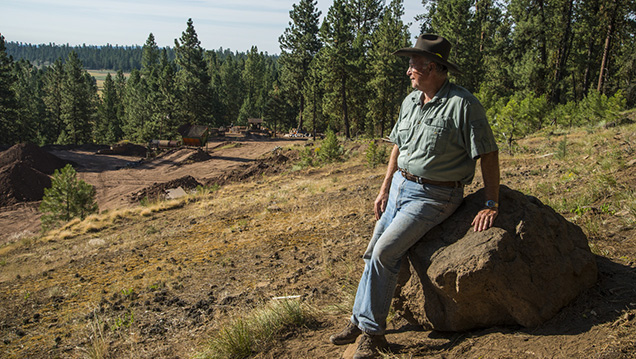
John Woodmark, CEO of the Ponderosa mine, is a man in his element. Photo by Robert Weldon.
THE MINE'S LOCATION
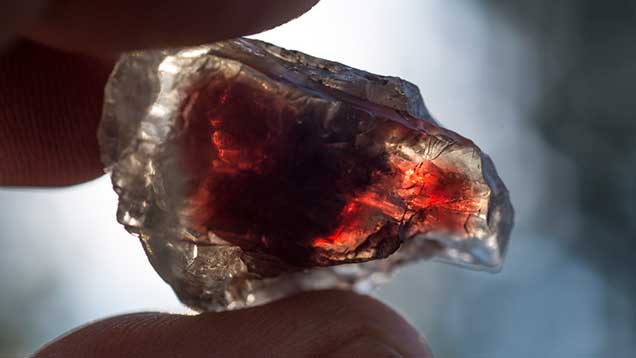
"With a sweep of his arm, John Woodmark invites us to take in the majestic vista below: “You can see the large meadow… it stretches for miles. That used to be an ancient lake…Native American people have been in here for 15,000 years, hunting around that lake.” He adds some more-recent history, telling us: “Into the 1900s, they were still camping in this area and using the dried-up lake bed as pasture for their horses.”
This connection to the native people extends to the present day. Woodmark partners with the local tribal outreach program to offer seasonal employment to Native American teens at the Ponderosa mine. This is something Woodmark is very proud of, and we’ll return to it a little later.
Right now, we’re standing on the steep slopes of Donnelly Butte, just above the Ponderosa mine’s pit. At our backs, magnificent stands of lofty ponderosa pines extend uphill. We are about a five-hour drive from Portland, Oregon, and the transition from that busy city to the silence and serenity of the Ponderosa is jarring.
Beneath us, entombed in an ancient lava flow, millions of carats of rough sunstone—Oregon’s state gemstone—await discovery. The Ponderosa mine is possibly the state’s most important source of the repeatable commercial sizes required by jewelry manufacturers.
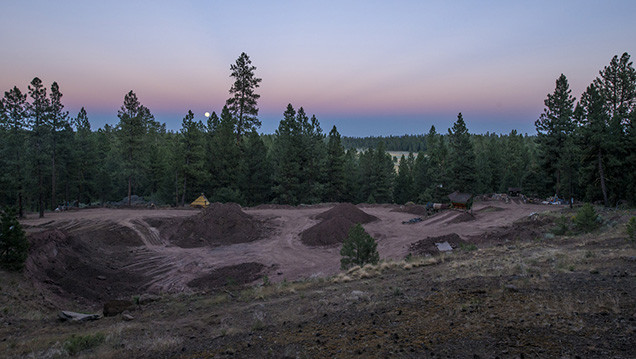
The red rocks of the Ponderosa mine’s pit complement the setting sun. Photo by Robert Weldon.
The beauty of the mine’s location isn’t lost on Woodmark: “It’s a pristine area, it’s beautiful…It’s wonderful just to come up here, let alone find a truly exotic gem like Oregon sunstone.” With this in mind, he strives to make his mining activities as low-impact as possible: “We’ve got over a million board feet of huge ponderosa, most of them in the 250 to 300 year old range, and we’re trying very hard not to disturb any of those trees and still get the same stones that we need to mine.”
Beyond the direct environmental impact, Woodmark and his crew also have to synchronize their mining to the regional climate. These are Oregon’s High Lava Plains, after all, and the winters can be brutal: “The mine is located at 5900 ft., so from October to June we’re covered with as much as ten feet of snow up here, so there’s absolutely no mining during those months.”
Despite these constraints, he knows the Ponderosa’s weathered reddish basalts are blessed with high concentrations of sunstone: “This mine is tremendously rich—the whole mine is 60 acres—and we get a kilo and a half of sunstone out of every cubic yard of dirt moved…so it’s arguably one of the richest gemstone mines in the world.”
Because of the richness of this deposit and the weathered nature of the basalt around the gems, they’re easier to recover than at some of Oregon’s other sunstone locations. Woodmark explains: “We do ten-day mining stints…sometimes four to five times throughout that four month period…It all depends on the demand for Oregon sunstones…the more demand, the more often we mine.”
(video)
Introducing the Ponderosa
John Woodmark, CEO of Desert Sun Mining & Gem, provides a brief history of the mine and its location, as well as explains how the Ponderosa’s location at 5,900 ft. affects the mining season.
BEAUTIFUL SUNSTONE
Woodmark is passionate about sunstone: “You never get tired of it…it isn’t like you’re mining amethyst, which is all purple. Ours is so many different colors, every stone is unique.” As he talks on, his enthusiasm and love of this unique gem is infectious: “You can get reds, with just a sprinkling of the copper platelets, which makes it look like you’re looking into a red sky with gold stars…It’s just gorgeous.”
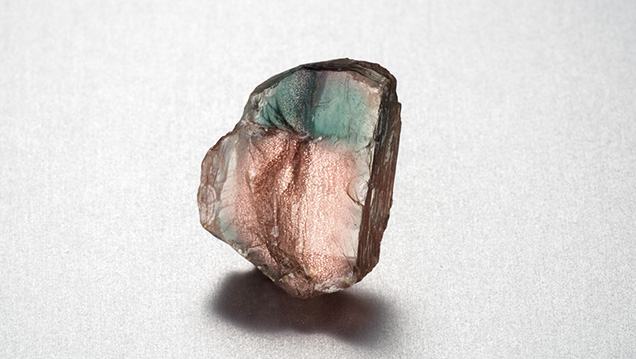
A rare 11.76-ct. bicolor sunstone gleams with an added bonus of glittering, reflective copper platelets. Photo by Robert Weldon.
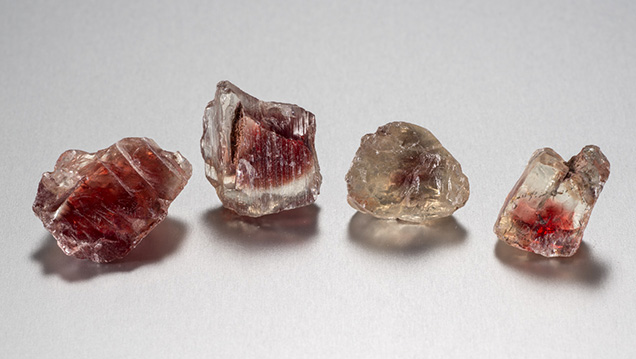
This group of red sunstones reflects recent production from the mine’s pit. Photo by Robert Weldon.
He draws our attention to sunstone’s unique hallmark—tiny particles of native copper metal that produce a glittering effect called schiller. “And then you have the intense schiller…When the sun hits it and it just pops out at you…you can’t even believe it!”
(video)
Beautiful Gems, Pristine Location
Owner John Woodmark introduces us to the Ponderosa Mine’s pristine location and explains how the gems from the mine mirror the natural beauty of the environment.
THE PONDEROSA MINING PROCESS
Woodmark is determined that we see all of the mine’s operations and witness the recovery of gem sunstone directly from the pit wall. We start right at the wall, which bears sets of deep, parallel gouges. He mentions this is the work of the “magic finger,” developed by a member of his crew as an attachment for their backhoe, and which makes mining much easier.
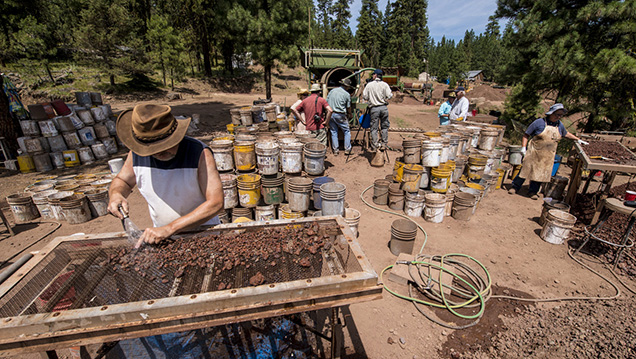
Pickers scour their screens for the gleam of red sunstone. Photo by Robert Weldon.
He directs us to a rich red area of the pit wall. “In the rest of the mine, we only get about one-and-a-half to three percent red.” This patch, he asserts, is very different: “This area produces twenty percent red to the volume that we’re picking…so rich it’s incredible.”
Woodmark adds that the backhoe’s special attachment—basically a flattened metal spike—was the missing ingredient: “We haven’t monkeyed around with anything else since we got our ‘magic finger’ to break this stuff down. Before, it was too hard for our machines to work.”
Once enough of the pit wall is torn down by the backhoe, a small loader moves the ore onto an area of the pit floor. Next, the Ponderosa crew runs their massive forty-thousand pound loader over the material to crush it and loosen the stones.
The loader feeds the crushed rock through a dry trommel—a rotating screen that, with the harsh clatter of stone on metal, separates the dirt from the ore-bearing material. The next stage is a second trommel, this time using water. John tells us this piece of equipment takes the concentrate and “washes it, scrubs it, and knocks off a little bit of the volcanic crust that’s on the crystals.”
One load fills about twenty five-gallon buckets. The buckets quickly stack up behind each of the three screening stations set up at the time of our visit.
A picker stands behind each screen. Woodmark picks up a bucket of concentrate and pours the contents onto a screen to demonstrate for us: “We…throw all the big rocks off…spread it out fairly evenly…” He picks up a hose and directs a jet of water over the concentrate. “…then come back and spray it down.”
He pauses to pick up a choice piece of sunstone. “Nice red,” he observes. “And then we start…systematically going through the whole screen.” With a small trowel, he works methodically from one end of the screen to the other, telling us, “What we try and do is turn every stone…leave no stone unturned we tell the kids…so you start at one end and you just systematically turn every stone.”
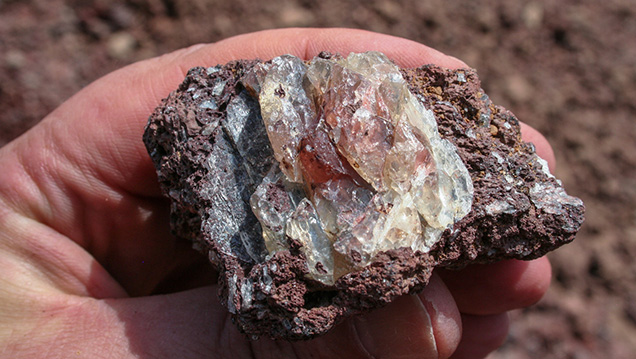
We recovered this nice specimen of zoned sunstone crystal in host basalt after it passed through the wet trommel. You can see that the crystal was originally considerably larger. Photo by Duncan Pay.
John’s diligence pays off with a small handful of rough sunstone, “You’ll get a handful like that off every screen…which probably weighs a few ounces.” He drops the red pieces into a plastic cup and tosses yellow or colorless rough into a bucket next to his feet. “They’ve got to go through a lot of screens to get a kilo…but like I say, they’ll pick about ten kilos on average per day.”
John emphasizes that speed is of the essence: It’s important to go through the screens quickly but accurately. “Don’t miss a thing, and get on to the next screen.” His rule of thumb is that the more screens you go through, the more you’re going to make: “I’ll do a screen every five-to-six minutes…it’s important not to jump around…because you’ll start to miss them.”
John’s eyes scan methodically from one end of the screen to the other, his trowel making quick movements to flip over the larger pieces: “A lot of our stones have a volcanic crust on them and even though they’ve gone through all the processes to get here, they’re very hard to find, so we go through it very methodically.”
“Don’t leave a stone unturned…” he admonishes us, “…because sure enough, there will be a red one hiding underneath there…and we don’t want to miss a red one.”
Once all the concentrate from a load is recovered, it’s washed for about an hour in a small cement mixer, which takes about 35 kilos at a time (60-70 pounds). “It’s almost like a rock tumbler…a giant rock tumbler,” Woodmark jokes.
When John tips out the mixer, there’s a crystalline glitter and tinkle as freshly washed rough cascades onto a small screen. “I’m looking for how many reds and how much schiller is in there…I’m looking for good stones that will bring money.”
He plucks out a limpid chunk of feldspar. “There’s a beautiful yellow…it’s a nice big size…see how clear and nice that stone is…that’ll make a terrific stone.” And then, a better prize: “Here’s a beautiful red…that’s going to make a tremendous faceted stone!”
The final step at the mine is to grade all this freshly cleaned concentrate. John leads us to a small table in front of the mine’s bunkhouse, where trays of sorted rough—reds, bicolors, schiller stones, yellows, and clears—rest in water-filled metal trays. The water cuts down reflections and helps with grading, he explains. There, in the shadow of tall ponderosa pines, John outlines the qualities a really fine gem might have: “The pinnacle is if it would be good enough to make a carving. A carving has to be something over 25 carats finished.”
He continues, “It has to have all the attributes…color…schiller…so it really is the pinnacle of an Oregon sunstone…We sell them for a lot of money…That’s just one in thousands of stones that we find.”
(video)
Mining Sunstone at Ponderosa
In this series, Ponderosa Mine owner John Woodmark explains how his crew goes about mining and processing, and grading rough sunstone.
NATIVE AMERICAN PICKERS
John is proud of his partnership with the local tribal outreach program, which started with five kids in 2006 and continues to the present. “We’ll pick for ten days at a stint,” John tells us. “After ten days, they’re burnt out picking stones and standing down there in the hot sun.”
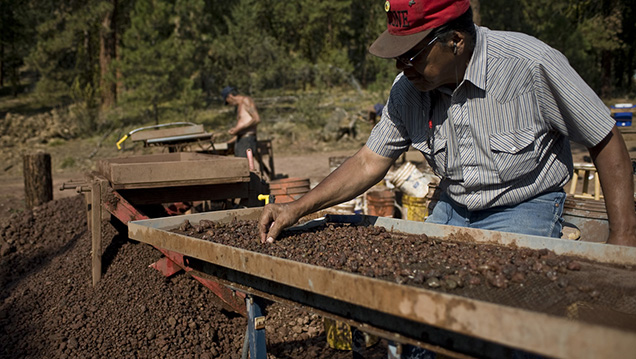
The Ponderosa partners with the local tribal outreach program to use Native American pickers. Photo by Jeff Jessing, Nature Revealed Photography, © 2009; courtesy of Desert Sun Mining Group
Unfortunately, at the time of our visit, there had been a robbery at the reservation and all the teens had left to assess the damage. However, each of us spent several hours working the screens, just as the pickers do. This gave us a very good concept of these kids’ “Ponderosa experience.”
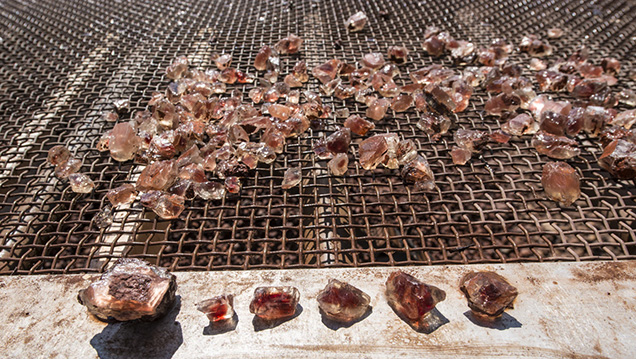
A lucky picker’s haul: A fine collection of “reds” decorate this screen. Photo by Robert Weldon
John outlines how his outfit houses, feeds, and pays the teen pickers: “For most of them it’s the most money they’ve ever had of their own…so the kids have all been absolutely great…they’re respectful, they’re glad to have a job, and all of us mentor them around the campfire.”
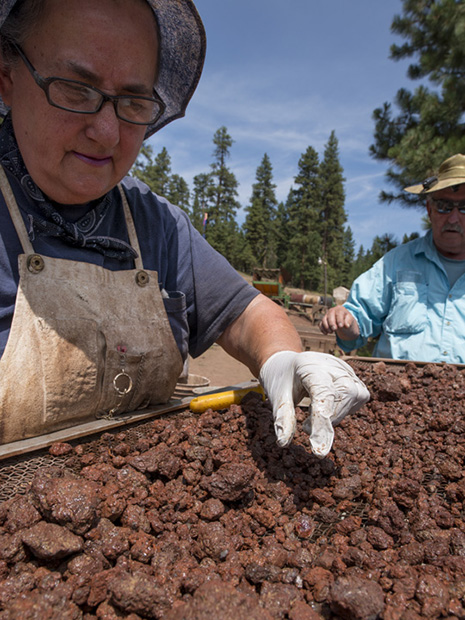
A red crystalline glint in a scattering of red rock attracts this worker’s attention.
Photo by Robert Weldon
To John, the amount of work he can provide hinges on the success of his business and, in turn, the popularity of sunstone with the jewelry-buying public. “The more sunstones we sell, the more people we can then hire,” he explains. “So if more people would get in behind Oregon sunstones, we’d have a lot more kids working here.”
(video)
Employing Native American Teens
The Ponderosa mine has an arrangement with the local tribal non-profit to provide work experience for Native American youth. The mine’s owner describes the benefits for both parties.
PROFIT
Woodmark is a savvy businessman, successful in many ventures before he acquired the Ponderosa mine. He applies the same financial acumen to sunstone as he would to any other commodity; “A kilo of red is worth twenty thousand dollars…we’ve got 25 of them in five days.”
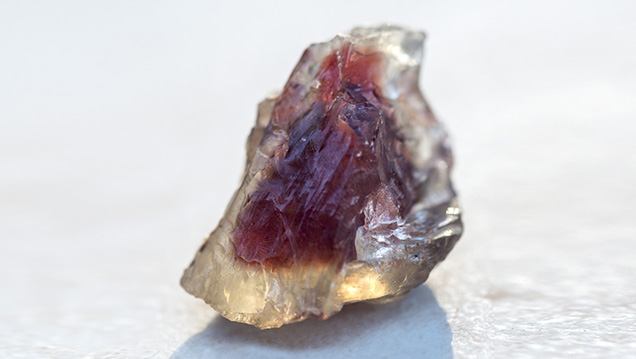
This choice piece of red sunstone rough will make a fabulous faceted gem. It’s just one piece in the 25 kilo haul the Ponderosa miners recovered during this trip. By Robert Weldon.
"We average 600 cut carats per kilo…an average price of ... "
https://www.gia.edu/gia-news-research-p ... nstone-pay